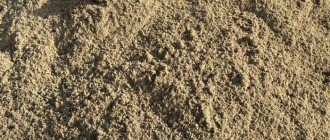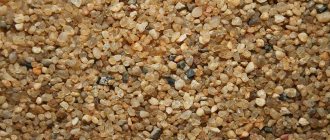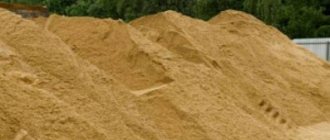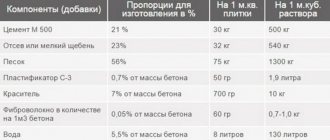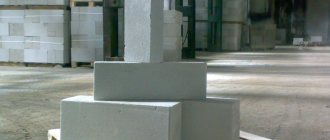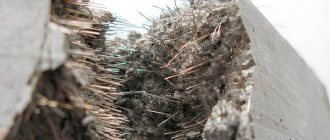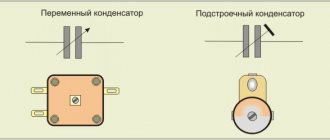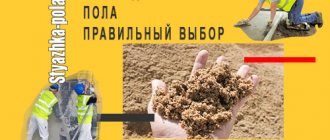Natural natural sand is a loose rock containing grains of feldspars, mica, quartz and other natural minerals. In fact, any sand is suitable for construction. Both river and sea or quarry are used, but the use of quarry is in demand due to its low price and good natural properties.
Description of building material
Quarry sand is almost a universal material that is used in many areas of the national economy and industry. Construction, road work and landscaping are key areas of application for quarry sand.
This sand is extracted by quarrying, as its name implies. Different quarries provide different types of sand with different textures, grain sizes and compositions. The final properties that quarry sand will have are also influenced by the methods of its extraction: washing, sifting and open mining.
Based on the coarseness and grain size, fine-grained, medium- and coarse-grained sand is distinguished. Fine-grained sand, whose grains have a diameter not exceeding 2 mm. Medium-grained - from 2 to 2.8 mm, and coarse-grained has grains of sand up to 5 mm.
The fact that quarry sand contains various impurities (sometimes their percentage reaches 7%) is a disadvantage on the one hand and an advantage in some cases.
In the case where sand is mined by open casting rather than by washing, the presence of clay makes it more convenient for mixing solutions. It settles less and makes the building composition more elastic and mobile.
Types of sand extracted from quarries
The sand extracted from different quarries differs significantly:
- graininess,
- structure,
- composition of impurities.
Extraction of quarry sand
The presence of minerals in the raw material determines what kind of sand it will be - yellow, red, brown or white. The grain size can vary from 0.15 to 5 mm. In this case, sand up to 2 mm is considered fine-grained, sand up to 2.8 mm is considered medium-grained, and coarse-grained up to 5 mm. It is quarry sand that has particularly large fractions, often used in the construction industry. The composition of sand from developments may contain various impurities that have a negative and positive effect on its properties. Each type of extracted raw material depends on the additives it contains and is used for its intended purpose.
Varieties of quarry sand
According to the type of processing used after extraction, sand is divided into:
- Alluvial (washed) - this type of quarry sand is extracted from watered deposits and deposits in quarries using hydromechanical equipment. Thanks to the use of this technology, the sand ultimately turns out clean, that is, without impurities and unnecessary components. During mining using hydromechanical devices, clay and dust particles are washed out of the sand. The use of alluvial sand is considered the most appropriate for the production of concrete and bricks, as well as in the construction of buildings, roads and reinforced concrete products.
- Screened sand is obtained as a result of simple technical and mechanical sifting of large particles and stones. This sand is perfect for forming plaster, preparing mortar for masonry or casting foundations.
- Sandy soil is an unrefined mixture of quarry sand with various components. The price for such sand is minimal, and the scope of use is, as a rule, limited to backfilling trenches or leveling the relief of a land plot.
This is what alluvial (washed) quarry sand looks like in the photo
Quarry mountain sand. Varieties
Sand extraction is not an easy task; it is important not only to deliver the rock to the surface, but also to process it.
Varieties:
- alluvial quarry sand – is mined in quarries using hydromechanical equipment. This technology of washing or washing the extracted sand with water allows you to get rid of foreign impurities and other components. The final sand is clean. How natural material is purified: directly during extraction, with the help of special equipment, sand goes through several stages of purification. Clay inclusions and dust particles are washed out of it. Indispensable in the production of building materials. In addition, such sand is widely used for the construction of reinforced concrete blocks and roads;
- seeded quarry sand - the rock is passed through special equipment. By sifting you can get rid of foreign impurities. This building material is suitable for mixing solutions. The sand is very soft to the touch, literally weightless;
- ground sand is mixed sand from a quarry with an admixture of foreign particles (up to 40%). The cost of such building material is low; it is used mainly for rough work: backfilling trenches and leveling surfaces.
The photo shows washed quarry sand.
Sand extraction in quarries: features of the process
Of course, the most popular is the open method, in which construction and mining companies can make do with ordinary equipment: excavators, bulldozers, etc. This method is quite cheap, so sand is not suitable for all work. Quarry sand mined in this way is usually located in the upper layers of the soil, so miners mainly use the technique of opening the upper layers and occasionally explosives.
For quarries flooded with water, a dredging unit is used, which is a powerful pump for unloading sand from the bottom. The floating pontoon on which the equipment is installed (the so-called dredger), is secured with anchors and cables, or is located on board a specially equipped vessel. The sucked sand is called "pulp" because it passes through a pulp channel, which screens out clean sand without impurities and returns water to the quarry. This method of extraction is called hydromechanized.
In other cases, other equipment may be used that has a specific purpose and is also not typical for regular use. For example, a sieve is used to sift stones and clay from open-pit sand. Instead, a regular metal mesh can be used, which allows you to sift the sand with your own hands. Before developing a new quarry, it is necessary to prepare all calculations and coordinate the work with government services.
Dredger S-42 sand extraction using hydromechanized method:
Why quarry sand is the cheapest
Quarry sand is an inexpensive and very popular material.
Compared to other types of sand, quarry sand, also called “gully” sand, is the easiest to obtain. Russia has huge reserves of this material. Even near Moscow there are huge deposits of it, for the extraction of which hydromechanical equipment is used. The resulting material has high humidity and also contains clay impurities, dust and small stones. Such sand is affordable, but due to its structure, its use is not appropriate everywhere. However, proper use of this material will significantly save your budget. In some cases, sand from a quarry is even more preferable, precisely due to additional impurities. The ideal option for using quarry material is rough work.
Technical characteristics and properties
The main property of quarry sand is its purity and absence of impurities. Moreover, alluvial quarry material has the following characteristics:
- Fractions vary from 1.5 to 5 mm.
- Low percentage of dust, clay and other impurities - no more than 0.03%.
- The density of alluvial quarry sand is 1.60 g/cm3.
Depending on what fraction the sand grain has, the alluvial material is divided into the following categories: small, large fraction and medium-sized fraction. The shades of quarry sand also differ and can be either amber-yellow or brown, depending on the deposits and the quarry.
Content of dust and clay particles
A high content of clay and dust elements can negatively affect the quality of the solution and concrete products, so the value of this parameter must be taken into account when purchasing.
According to GOST, the content of dust and clay particles in quarry sand should be up to 7%. The indicator varies depending on the class and size modulus of the material. In the quarries of our region, sand containing from 0.5 to 2.2% of such particles is extracted. This means it's pretty clean.
You can also find out whether the sand contains foreign impurities through a visual inspection.
Please note the following photo:
On the left is a sample of unprocessed quarry sand, which is sold immediately after extraction. On the right is washed quarry sand (otherwise it is also called alluvial sand). The color of the left sample is richer and darker due to admixtures of clay particles, while the right one is lighter and purer.
Areas of application
Due to the exceptional quality of quarry sand and its compliance with GOST 8736-93, it is widely used in the construction industry, the national economy, and decoration. The use of sand is especially relevant and cost-effective in the production of bricks and concrete, as well as in housing and road construction.
Coarse-grained quarry sand has gained great popularity in the production of high-strength concrete and various reinforced concrete structures. Paving slabs, stonework and street curbs also use quarry sand in their production. And due to the absence of impurities, the resulting materials will have exceptional strength and durability.
Surface and coating mortars use sand with a fine grain fraction, which makes it possible to achieve an aesthetically attractive appearance of the final mixture. Decoration and use in summer cottages and children's playgrounds makes the extraction of fine sand quite profitable.
Some more information about using quarry sand:
Scope of application of quarry sand
Quarry sand is considered one of the most common building materials of natural origin. Fine-grained products are in demand in the manufacture of plaster and grout mortars, allowing for a fine surface texture and eliminating the need for additional putty.
Pre-washed coarse sand is much more popular in the construction industry, where it is used in the production of concrete, plaster mortars, lining materials, wells, etc.
Seeded analogues of medium and fine fractions are used at the stage of preparatory work, namely for:
- backfilling pits;
- making a pillow for the foundation;
- sprinkling of the construction site;
- drainage structures;
- road construction as a cushion.
The demand for quarry sand in the construction industry is due to its availability and versatility. If there are no special requirements for the construction, the use of non-metallic material mined in a quarry is advisable.
Advantages and disadvantages of quarry sand
For enterprises that mine and sell sand, gravel and granite, sand is usually a priority material. What is its popularity? Mostly due to the fact that compared to other types of sand (for example, quartz), quarry sand is not at all expensive.
This is because:
- Enterprises do not spend resources on cleaning sand. Since quarry sand cannot be impacted or processed, businesses save money on cleaning and screening quarry sand.
- The extraction process is very simple. Absolutely, the simplest, cheapest and most common method is open, which is used by the vast majority of mining companies.
- Low delivery price. There are a lot of quarries with sand deposits, so you can always find the required amount of sand nearby.
Although the performance of quarry sand does not match that of alluvial or seeded sand, its reasonable price and other quality characteristics make this sand more popular and in demand than its analogues.
Types of quarry sand:
- No additional processing. The presence of impurities limits the use to areas where high-quality material is not needed: leveling the terrain, filling trenches, changing the composition of the soil, or preparing crushed stone-sand mixtures.
- Sieved. This material is used as a filler for building mixtures and cement mortars. It is homogeneous and has high adhesion rates.
- Alluvial. Selected for the preparation of high quality construction and finishing mixtures and concrete solutions. Abrasive materials are made from fine fractions.
Screened and alluvial sand of large fractions is needed for the manufacture of building blocks, paving slabs and decorative forms. The purified material with a high quartz content is used to make glass.
